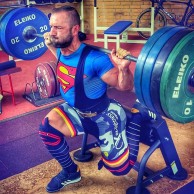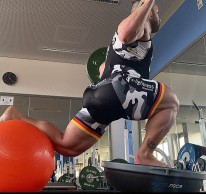Bulgarian split squat, a basic part of any strength routine
The Bulgarian split squat is one of the basic exercises that should be in every athlete's strength routine. It is a fairly complete leg exercise that involves a large number of muscles, but we can decide whether to focus more on the gluteus or the quadriceps with a slight change in technique.
Why you should include the Bulgarian split squat in your routine: benefits
The Bulgarian split squat has the advantage that you hardly need any equipment to perform it, but it also has a long list of benefits.

To begin with, they mainly work the hips, hamstrings, quadriceps, glutes and knee and are a good exercise for toning the legs and glutes.
RECOMENDADO

When do helmets have to be changed? Do they have an expiration date?

The best apps for cycling and mountain biking

Black Friday 2025 cycling bargains: save on Garmin, POC, Maxxis and more

Black Friday Garmin 2025: the ultimate guide to choosing your GPS at the best price

Which profile wheels to choose according to the area where you live: mountain, flat or coast

How to wash your cycling clothes? 10 keys to make them always look new
Even so, if they have become one of the exercises of choice for many, it is because they also exercise other parts of the body, such as the ankles, the core or even the lower back.
In this type of squat, most of the effort falls on one leg. This is known as a monopodal exercise. This activates the core and makes it stronger. At the same time, hip mobility is also worked and the symmetry of the body is improved.
Finally, other key aspects that will be strengthened after doing Bulgarian split squats are balance, coordination and flexibility.
How to perform the Bulgarian split squat correctly
As with any exercise, knowing the technique will allow us to work the muscles correctly and avoid possible injuries. Let's take it one step at a time.
First of all, we must pay attention to the position. We must leave adequate space between the leg that is in contact with the ground and the object that we will use to support the other leg (a bench, a chair, etc.), which we will place behind us. If we sit on the support object and stretch out one leg, we will know approximately where to place the foot that touches the ground.
It is important that the object is at knee height so that the leg supported forms a 90º angle while the other leg is perpendicular to the ground. On the other hand, we must try to support the entire instep, so it will be much more comfortable if the surface is soft.

Once you are in place, it is time to start. Bend the leg that is straight - the one touching the ground - until your thigh is parallel to the ground. The movement should describe a slight diagonal backwards.
The knee should be more or less above the ankle, while the knee of the supported leg should also be lowered at the same time. We have to load our efforts on the leg that touches the ground and leave the leg that is supported only as a support. When we have done this, we return to the starting position.
As we said before, slightly varying the way we do them will make some muscles more important than others. In particular, we can choose whether to work more intensely on the glutes or the quadriceps, depending on what we are most interested in.
For greater activation of the buttocks, the feet should be further apart. In this case, we will notice that the back should be more inclined - although it must be kept straight - and there will be a greater flexion of the hips.
If, on the other hand, you want to get more out of your quadriceps, simply reduce the distance between your feet. In doing so, the trunk will be less inclined and the descent will be more vertical.
Having said all this, it is time to review the main mistakes we can make. One of the most obvious is choosing a bench, chair or other support object that is not the right height, does not sit well on the floor or is too hard and hurts us.
Until we polish the technique we will have to pay attention to avoid bringing the knee forward more than the toe of the foot, keep the back with a slight forward lean, place the feet so that they point forward and keep the chest outwards.
Bulgarian split squats can be harmful for people with knee, meniscus or hip problems, so in these cases you should consult a specialist before deciding to include them in your routine.
Bulgarian Split Squat with Dumbbells
When performing Bulgarian split squats, different elements can be introduced. One of the most popular are dumbbells. It is important to note that adding dumbbells will require extra strength and balance. It is therefore advisable to master Bulgarian split squats before adding dumbbells.
They can be done with one or two dumbbells. If you use one: if you hold it with the hand on the side of the supported leg, you will work more on your glutes; if you hold it from the side of the leg that is straight, it will be more suitable for working more on your quadriceps.
Including dumbbells in Bulgarian split squats will also work the arms, shoulders, back and lats to some extent.
Bulgarian split squat on barbell or on Multipower
This is another variation of the Bulgarian split squat. In this case, a barbell is used on the shoulders, which increases muscle development. It is a demanding exercise that also requires mastery.
In this case, squats will almost certainly be reserved for the gym and both legs and buttocks will be strengthened.
When using both dumbbells and barbells it is very important to know the optimal weight to lift in order to avoid injury.